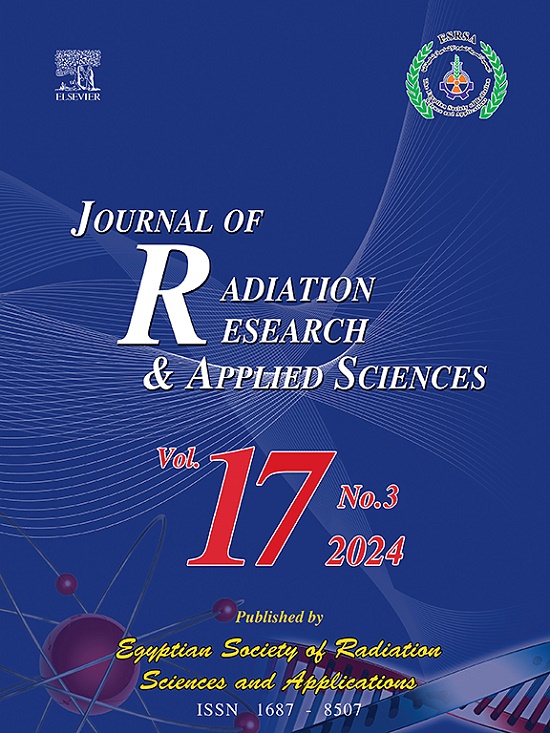Novel attention-enhanced Multi-Task Deep learning for knee osteoarthritis (KOA) grading and localization in X-ray imaging of basketball players
IF 1.7
4区 综合性期刊
Q2 MULTIDISCIPLINARY SCIENCES
Journal of Radiation Research and Applied Sciences
Pub Date : 2025-03-23
DOI:10.1016/j.jrras.2025.101442
引用次数: 0
Abstract
Objective
This study aims to develop and evaluate a novel attention-enhanced multi-task deep learning framework designed to automatically detect, grade, and localize the severity of knee osteoarthritis (KOA) in basketball players through X-ray imaging. The framework utilizes the Kellgren-Lawrence (KL) grading system, categorizing KOA severity into grades 1 to 4, to enhance diagnostic accuracy, reliability, and clinical applicability.
Materials and methods
The dataset consisted of 2135 knee X-ray images from basketball players, labeled with KL grades ranging from 1 (Normal) to 4 (Severe). The images were preprocessed using normalization and data augmentation techniques, such as rotations, flips, and intensity adjustments, to increase diversity and enhance model performance. YOLOv11, built on the YOLO framework, incorporated architectural improvements like enhanced feature pyramids, adaptive anchor thresholds, and attention mechanisms. These features allowed the model to simultaneously detect, classify, and locate pathological features. The model was trained for 500 epochs using a composite loss function that balanced the objectives of detection, classification, and localization. Hyperparameter tuning was used to optimize the learning rate, batch size, and anchor thresholds. The model's performance was evaluated using metrics like mean Average Precision (mAP), Intersection over Union (IoU), and classification measures such as precision, recall, accuracy, and F1 score on training, validation, and testing datasets.
Results
YOLOv11 achieved a final mAP of 97.23 % and IoU of 96.54 %, outperforming YOLOv10 (mAP: 95.58 %, IoU: 92.16 %) and YOLOv9 (mAP: 93.14 %, IoU: 90.12 %). The model also showed excellent classification performance, achieving an accuracy of 97.70 % on the training dataset, 96.22 % on the validation dataset, and 95.59 % on the testing dataset. It effectively identified KOA-related features with minimal errors, as shown by confusion matrices and t-SNE visualizations, which displayed clear clustering of KL grades.
Conclusions
YOLOv11 marks a significant step forward in the automated assessment of KOA, offering high precision, accuracy, and reliable localization. Its success with basketball players indicates its potential for use in other athletic populations and broader clinical applications.
基于注意力增强多任务深度学习的篮球运动员膝关节骨性关节炎(KOA)分级与定位研究
本研究旨在开发和评估一种新的注意力增强多任务深度学习框架,该框架旨在通过x射线成像自动检测、分级和定位篮球运动员膝关节骨关节炎(KOA)的严重程度。该框架采用Kellgren-Lawrence (KL)分级系统,将KOA严重程度分为1至4级,以提高诊断的准确性、可靠性和临床适用性。材料和方法数据集由2135名篮球运动员的膝关节x射线图像组成,标记为KL等级从1(正常)到4(严重)。使用归一化和数据增强技术(如旋转、翻转和强度调整)对图像进行预处理,以增加多样性并提高模型性能。基于YOLO框架构建的YOLOv11整合了架构改进,如增强的功能金字塔、自适应锚点阈值和注意力机制。这些特征使模型能够同时检测、分类和定位病理特征。使用平衡检测、分类和定位目标的复合损失函数对模型进行500次训练。使用超参数调优来优化学习率、批处理大小和锚定阈值。该模型的性能使用诸如平均平均精度(mAP),交集超过联盟(IoU)等指标以及诸如精度,召回率,准确性和训练,验证和测试数据集上的F1分数等分类措施进行评估。结果syolov11的最终mAP为97.23%,IoU为96.54%,优于YOLOv10 (mAP: 95.58%, IoU: 92.16%)和YOLOv9 (mAP: 93.14%, IoU: 90.12%)。该模型在训练数据集、验证数据集和测试数据集上的分类准确率分别达到97.70%、96.22%和95.59%。它以最小的误差有效地识别koa相关特征,如混淆矩阵和t-SNE可视化所示,它们显示出清晰的KL等级聚类。结论syolov11在KOA自动评估方面迈出了重要的一步,具有较高的精密度、准确度和可靠的定位。它在篮球运动员身上的成功表明了它在其他运动人群和更广泛的临床应用中的潜力。
本文章由计算机程序翻译,如有差异,请以英文原文为准。
求助全文
约1分钟内获得全文
求助全文
来源期刊

Journal of Radiation Research and Applied Sciences
MULTIDISCIPLINARY SCIENCES-
自引率
5.90%
发文量
130
审稿时长
16 weeks
期刊介绍:
Journal of Radiation Research and Applied Sciences provides a high quality medium for the publication of substantial, original and scientific and technological papers on the development and applications of nuclear, radiation and isotopes in biology, medicine, drugs, biochemistry, microbiology, agriculture, entomology, food technology, chemistry, physics, solid states, engineering, environmental and applied sciences.
 求助内容:
求助内容: 应助结果提醒方式:
应助结果提醒方式:


